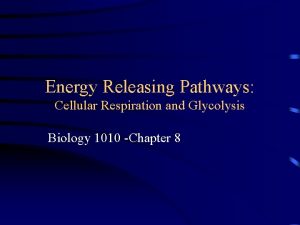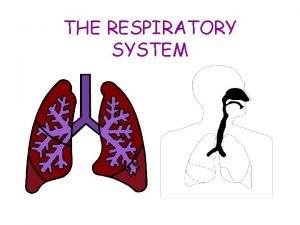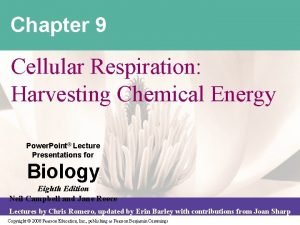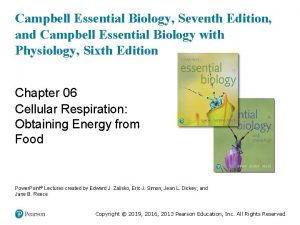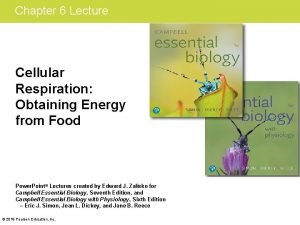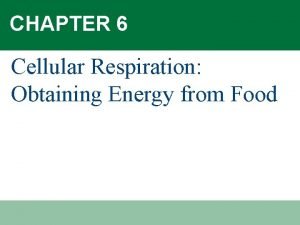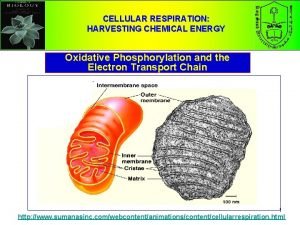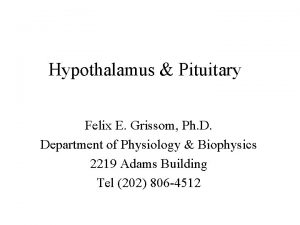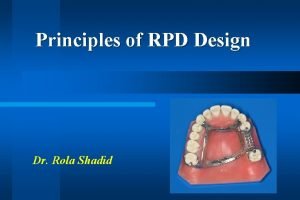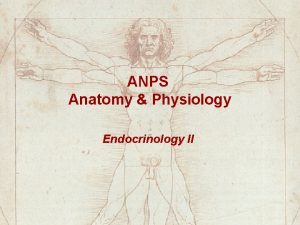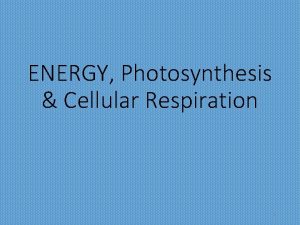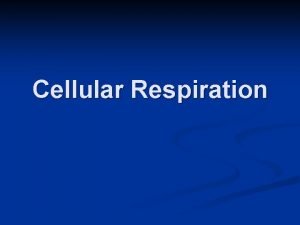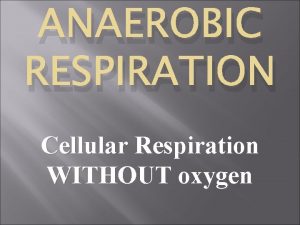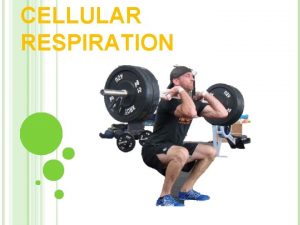Cellular Respiration Cellular respiration is releasing energy from















- Slides: 15

Cellular Respiration

Cellular respiration is releasing energy from glucose and other foods in the presence of oxygen.

Occurs in the mitochondria of both animals and plants.

Cellular Respiration (aerobic) Energy->ATP and heat REACTANTS PRODUCTS

Reactants Products • Glucose (C 6 H 12 O 6) Energy (36 ATP) • Oxygen (aerobic) Byproducts… -water -CO 2 (carbon dioxide)

Cellular Respiration • Starts with Glycolysis (process producing ATP molecules) • It then goes in one of two directions depending on whether oxygen is available. • If O 2 is available -> Krebs (Citric Acid) Cycle … Electron transport chain (all aerobic) • If O 2 is NOT available -> Fermentation (anaerobic)

Aerobic: process which requires oxygen

Fast Facts… • Glycolysis (1 st step in respiration) is very fast, can produce thousands of ATP molecules in under a second!

Rigor Mortis • Why do dead vertebrate animals become stiff shortly after death? • Body ceases (stops) doing cellular respiration. No ATP produced. No energy for muscle movement.

Anaerobic respiration (fermentation) • Releasing energy from food by producing ATP w/out oxygen 2 types of fermentation 1) alcoholic fermentation (plants, bacteria) -produces alcohol and CO 2 2) lactic acid fermentation (animals) -produced in muscles during rapid exercise…

Alcoholic and lactic acid fermentation • Alcoholic fermentation – yeast use this, they run out of oxygen, give off CO 2 • Lactic acid fermentation- oxygen not being supplied fast enough to muscle cells…ATP can’t be produced as quickly – Thus, muscle cells must produce their own ATP by lactic acid fermentation

Evidence of alcoholic fermentation

Summary… Aerobic Respiration • GLYCOLOSIS -> Kreb’s Cycle -> E. T. C • lots of ATP (36 per 1 glucose molecule) • endurance • no harmful effects

Anaerobic respiration (fermentation) • little ATP (2 per glucose molecule) • short bursts of energy • lactic acid (animals) or alcohol (other organisms) is also made…both harmful

Gotta get that ATP! YOUtube video Click
 Energy-releasing pathways
Energy-releasing pathways The energy-releasing process that is fueled by oxygen
The energy-releasing process that is fueled by oxygen The stages of cellular respiration
The stages of cellular respiration Energy flow in cellular respiration
Energy flow in cellular respiration Chemical cycling in an ecosystem
Chemical cycling in an ecosystem Chapter 9 cellular respiration harvesting chemical energy
Chapter 9 cellular respiration harvesting chemical energy Chapter 9: cellular respiration: harvesting chemical energy
Chapter 9: cellular respiration: harvesting chemical energy Cellular respiration obtaining energy from food
Cellular respiration obtaining energy from food Cellular respiration obtaining energy from food
Cellular respiration obtaining energy from food Electron transport chain summary
Electron transport chain summary Chapter 8 section 1 how organisms obtain energy
Chapter 8 section 1 how organisms obtain energy Releasing inhibiting hormones
Releasing inhibiting hormones Reciprocal plate rpd
Reciprocal plate rpd Corticotropin releasing hormone
Corticotropin releasing hormone Maxine greene releasing the imagination
Maxine greene releasing the imagination Alter cast technique
Alter cast technique
